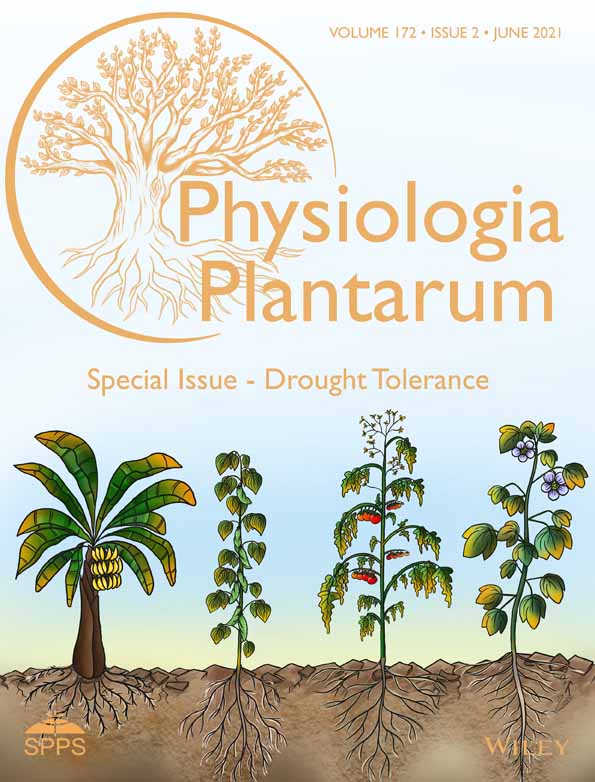Melatonin improves the seed filling rate and endogenous hormonal mechanism in grains of summer maize
Edited by: V. Hurry
Funding information: High Technology Research and Development Program of China, Grant/Award Number: 2013AA102902; National Natural Science Foundation of China (2018–2021), Grant/Award Number: 31760354; China Post Doctoral Science Foundation, Grant/Award Number: 2020M683618XB
Abstract
The unpredictable precipitation and water deficit conditions in semiarid regions significantly reduce the yield of summer maize. The exogenous application of plant growth regulators can be used as a strategy to enhance plant stress tolerance and improve the growth and yield of maize under semiarid conditions. Here, we studied the protective role of melatonin application on maize yield using grain filling rate and hormonal crosstalk in maize grains. In the first field experiment, seeds were soaked with melatonin at a concentration of 0 (SM0), 25 (SM1), 50 (SM2), and 75 μM (SM3) μM. In contrast, in the second experiment, melatonin was applied on the foliage at the ninth leaf stage at a concentration of 0 (FM0), 25 (FM1), 50 (FM2), and 75 (FM3) μM. Our findings showed that melatonin treatments as seed soaking significantly increased single seed weight, seed filling rate in superior, medium and inferior seeds by regulating the hormone levels compared to foliar application. Application of melatonin significantly increased the zeatin+zeatin riboside (Z+ZR), indole-3-acetic acid (IAA), and gibberellic acid (GA) contents. However, it significantly inhibited the contents of abscisic acid (ABA) during the seed filling period. The content of Z+ZR, IAA, and GA was positively correlated with the maximum seed filling rate, seed weight, and mean filling rate in middle, superior and lower seeds, while the ABA was negatively correlated. The ABA content in inferior seeds was positively correlated with the maximum and mean seed filling rate. In semiarid regions, melatonin treatment of SM2 and FM2 significantly increased the dry matter per plant, 100-grain weight, seed filling rate, IAA, Z+ZR, GA contents, ear characteristics, and maize yield.
1 INTRODUCTION
Plant crops are exposed to environmental factors limiting the production and quality of the crops. Climate change and global warming are the major concerns challenging food security worldwide: the earth's temperature has increased in the last few years, the rainfall pattern has become unpredictable and drought stress prevails (Ullah et al., 2018). In arid and semiarid areas of the north-western loess plateau of China, the production of maize is entirely dependent on rainfall (Ahmad et al., 2019); however, limited and erratic precipitation during the growing season in these regions leads to drought stress and, as a result, reduces the production of maize crops (Ahmad et al., 2018; Kamran et al., 2018; Ren et al., 2009). In the semiarid areas, enhancing crops yield is a major challenge due to the scarcities of water (Li et al., 2016). Previous research determined that an arid and semiarid area has limited underground water and unpredictable precipitation. In semiarid environment, soils are not conducive to effective water absorption, which in addition to continuous water shortages and seasonal drought seriously restrict maize yields (Gan et al., 2009; Turner, 2004). The scarcity of water during the flowering stage and grain filling process causes a significant decrease in grain yield (Guo et al., 2014). However, the application of plant growth regulators (PGRs) or nutrients plays a crucial role in growing crop production (Lv, Tong, et al., 2017, Kamran et al., 2018, Ahmad et al., 2020). For instance, melatonin increased crop growth and development under water stress conditions (Arnao & Hernández-Ruiz, 2014; Arnao & Hernández-Ruiz, 2015).
Melatonin (N-acetyl-5-methoxytryptamine) is an “old friend” and a familiar animal hormone and plant growth regulator discovered in the bovine pineal gland (Arnao & Hernández-Ruiz, 2014; Lerner et al., 1958). Exogenous use of melatonin has been shown to improve the plant's ability to withstand harsh environmental conditions (Zhang et al., 2014). Melatonin is a plant growth regulator that protects the plant against multiple stresses, that is, biotic and abiotic (Arnao & Hernández-Ruiz, 2015; Wang et al., 2018). Melatonin is involved in the biosynthesis and catabolism of gibberellic (GA) and abscisic acids (ABA) in cucumber under salinity stress (Hai-Jun et al., 2015; Nawaz et al., 2015). Melatonin application enhanced stress tolerance and delayed the process of leaf senescence, which was related to the reduction of the ABA contents and downregulation of the ABA-related gene (Jing et al., 2017; Li et al., 2015). Exogenous melatonin application enhanced the endogenous melatonin and cytokinin contents (CK), while it reduced the ABA contents in ray grass under heat stress conditions (Jing et al., 2017). Previous research reported that Brassica juncea and tomato plants treated with melatonin slightly improved the endogenous indole-3-acetic acid (IAA) in comparison with non-treated plants (Chen et al., 2009; Wen et al., 2016). Application of melatonin delayed leaf senescence, improved the heat-induced growth inhibition, chlorophyll retention, and rate of photosynthesis and CK level in ray grass and tobacco during heat stress (Jing et al., 2017; Li et al., 1992). Melatonin affects the ABA and GA biosynthesis and catabolism during the seeds germination under salinity stress condition in cucumber (Hai-Jun et al., 2015). Previous studies suggested that melatonin treatment significantly affected the endogenous plant hormones but the biochemical mechanism for growing maize crop production in the semiarid region is little understood.
Plant hormones, including IAA, ABA, GA, CK, jasmonic acid (JA), and ethylene, play a crucial role in the cycle of grain filling process, plant growth, and development in water deficit condition (Brenner & Cheikh, 1995; Wang et al., 2018). In the early stage of seed development, the levels of different hormones such as ABA, IAA, and Z+ZR increased abruptly at the beginning of the process and then gradually decreased until crop's maturity (Gao et al., 2000). In maize seeds, the higher IAA and lesser ethylene significantly correlated with the maximum grain filling rate (Yang & Zhang, 2006). At the early grain filling stage of cereal crops, the contents of IAA, ABA, and ZR were higher in superior grains as compared to inferior grains (Guowei et al., 2007). The IAA, ABA, and Z+ZR correlated positively with GA3, which is negatively correlated with grain filling in maize crops (Yun-Ji et al., 2013). In maize seeds, the GA content is significantly associated with the grain filling rate (Yang et al., 2001). The Z+ZR are members of the cytokinin family; they enhanced fertilization during kernel set and endosperm development stage in the winter seeds of cereal crops to regulate the seed filling process (Morris et al., 1993). Previous research reported that higher cytokinin levels were correlated with spikelet development, early grain filling, and endosperm development of rice (Yang et al., 2000). Earlier studies showed that superior grains had higher content of Z+ZR and activity of synthase and ADP-glucose pyrophosphorylase (AGPP), but less ethylene than the inferior grain (Liang et al., 2017). A previous study has also shown that lower grains have higher temporal and spatial variations than higher grains, whereas lower grains are more prone to environmental stress (Chang, 2010). The higher Z+ZR level in the grains is an important condition for wheat crop seed filling and the endosperm development and cell division of grains (Morris et al., 1993).
Previous research concluded that the application of melatonin plays a crucial role in regulating plant hormones and protects the plants from various stresses (Back & Richmond, 2010; Li & Guo, 2018). However, the effect of melatonin application on endogenous hormones and the grain filling process in maize crop is not fully understood. Therefore, in the present study, we investigated the potential effects of foliar application of melatonin on endogenous levels of hormones during the grain filling stage. The study also focused on finding the optimal concentrations of melatonin foliar spray and seed soaking to regulate the grain filling rate and hormonal crosstalk. The results of this study provide convincing evidence of the relationship between melatonin, grain filling rate, and endogenous hormone levels to increase maize yields in semiarid regions.
2 MATERIAL AND METHODS
2.1 Experimental site description
The field experiments were conducted during 2017 and 2018 summer seasons at the North West A&F University, Yangling Shaanxi Institute of Water-Saving Agriculture in the semiarid region of China (longitude 34°20 N, latitude 108°04E and attitude 466.7 m). The daily maximum, minimum, and average maize-growing season temperature and precipitation were shown (Figure 1). The experimental location means air and precipitation temperatures were 12.9°C and 580 mm, respectively. The soil of the experimental site at the top (0–40 cm) soil layer was analyzed before sowing the maize in growing seasons for soil chemical properties: N-0.95 g kg−1, P-137.1 mg kg−1, K-0.95 g kg−1, and organic matter (13.62 g kg−1).
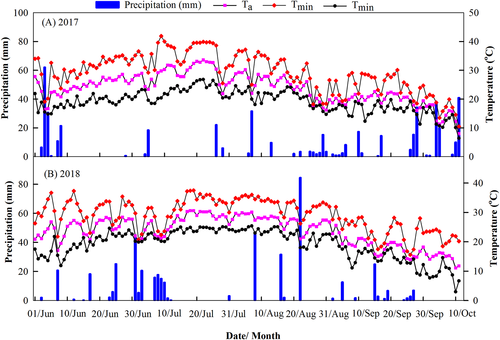
2.2 Experimental design, treatments, and management
The well-known maize hybrid cultivar (cv.) Zhengdan 958 was used. The experiments were organized in a Randomized Complete Block Design (RCBD) with three replications. The plot size was 35 m2 (7 × 5 m) with 60 cm of row spacing, 20 cm of plant spacing, and a planting density of 82,500 ha−1. The recommended amount of fertilizer (240 kg ha−1 nitrogen, 150 kg ha−1 phosphorus, and 150 kg ha−1 potassium) was used. Half dose of nitrogen and a complete/full dose of phosphorus and potassium was applied at the time of sowing, while the remaining half of nitrogen was given during the jointing stage. The seeds were manually sown on 6 June and 8 June and harvested on 7 October and 4 October in the 2017 and 2018 growing season of summer maize, respectively. The experiment included three specific melatonin concentrations along with control treatment, two methods of application, seed soaking, and foliar application. The seeds were first sterilized for 15 min with a solution of 3% sodium hypochlorite (NaClO), washed with 3–4 times distilled water. After sterilization, the seeds were soaked in melatonin at 0 (SM0), 25 (SM1), 50 (SM2), and 75 (SM3) μM L−1 and put in an incubator at 25°C for 12 h. Before sowing, the sterile paper was used for seeds drying at room temperature for 12–18 h until moisture contents reached 10–12%. For the second experiment, the same concentrations of melatonin 0 (FM0), 25 (FM1), 50 (FM2), and 75 (FM3) μM L−1 were repeatedly sprayed at the ninth leaf stage with 3 days intervals between 16:00 and 17:00 h. Tween-20 (0.1%) was used as a surfactant material with melatonin applied as foliage. The same volume of distilled water with Tween-20 was sprayed for control treatment. Natural precipitation was the only source of water for all growing seasons. Weeds were eliminated manually and all other agronomic (hoeing, thinning…) practices were uniformly carried out during both growing seasons.
2.3 Plant sampling measurements
Hundred plants were selected and tagged at the beginning of the silking stage for ear collection in each treatment. Every 5 days, three tagged ears were sampled in each treatment from silking to physiological maturity stage. The ear was divided into three parts (superior, inferior, and middle) according to its length and the seeds were collected from the different parts. Half of the seeds were dried in an oven at 75°C until they reached a steady weight (to check filling characteristics), while the remaining half seeds were treated with liquid nitrogen, then processed at −80°C for appropriate hormone content measurements.
2.4 Seed filling process
 (1)
(1) (2)
(2)Where W is the seed weight (mg), A is the final seed weight (mg), t is the timing after silking, B, K, and N are the coefficients determined by regression. The active seed filling duration was defined when W was between 5% (t1) and 95% (t2) of A.
2.5 Measurement of endogenous hormone contents
To extract and purify ABA, Z+ZR, and GA extraction and purification, the protocol of Yang et al. (2001) was used. Seeds (0.5 g) were ground in a mortar containing 5 ml of methanol extraction buffer and 1 mmol L−1 butylated hydroxytoluene as an antioxidant. The extract was incubated at 4°C for 4 h and then centrifuged at 4°C at 10000g for 15 min. The supernatants were passed through Chromosep C18 columns and pre-washed with 10 ml of 100% methanol and then washed with 5 ml of 80% menthol. The hormone fractions were dried in 1 ml of phosphate buffer saline with N2 dissolved in 0.1% (v/v) between 20 (surfactant) and 0.1% (w/v) gelatin (pH 7.5) for enzyme analysis associated with immunosorbent assay evaluation (ELISA). Previously study notified the quantification technique for Z+ZR, ABA, and GA contents through ELISA (Yang et al., 2001). The recovery rate of Z+ZR, ABA, and GA was 90.5 ± 3.7%, 90.1 ± 3.6%, and 78 ± 4.8%, respectively.
2.6 Total dry matter accumulation
In each block (replicate), only plants from the central rows were chosen for measuring dry matter accumulation. For each treatment, nine plants per replicate (three replicates) were selected and cut at the ground in different growth stages such as the ninth leaf stage (V9), silking stage (R1), grain filling stage (R3), and physiological maturity stage (R6). For the constant dry weight, the plant sample was put in the oven at 105°C for half-hour and then at 75°C for 72 h. Electronic balance having an accuracy of 0.000 was used to weight the plant samples.
2.7 Characteristics of maize ear and grain yield
Maize was harvested from three central rows for each treatment, the characteristic of ear and yield-related data were calculated. The ear was removed from the husk before threshing and air-dried for 1 week. The length of the ear, ear diameter, rows per ear, and grain per rows were counted manually from the selected cobs after the measurement of 100-grain weight. The grain yield (kg m−2) was estimated at 12% moisture content after the grain was dried.
2.8 Statistical analysis
The statistical analysis was conducted using variance analysis (anova) and SPSS 13.0, where the mean difference in comparison was calculated using Fisher's lsd test P ≤ 0.05. During both growing seasons (2017 and 2018), the characteristics of grain filling rate and endogenous hormone content were not significant; therefore, data from 2018 were used to measure grain filling and hormone content. For the determination of correlation analysis between grain filling and hormone contents, Pearson's correlation was used. The data are analyzed separately for each sample.
3 RESULTS
3.1 Seed filling process and 100-grain weight
The application of melatonin as a foliar spray and seed soaking significantly improved the maximum and mean filling rate of seeds. Figure 2 and Table 1 indicated that the maximum seed weight, as well as maximum and mean seed filling rates of the superior, middle, and inferior seeds, increased as the seeds mature. Higher endogenous content of IAA and Z+ZR significantly contributed to the seed filling rate. The melatonin SM2 treatment significantly improved the maximum weight of seed as well as maximum and minimum seed filling rate compared with the FM2 treatment. In the early days after silking, the seed filling rate increased significantly and then gradually declined until seed maturity. The application of melatonin substantially increased the filling levels at different seed positions. In middle and superior seeds, the maximum filling rate was reached at 20 DAS (days after silking) upon melatonin treatments SM2 and FM2, while it was reached a maximum at 25 DAS in the inferior seeds. Our results indicated that the application of melatonin as seed soaking increased more the seed filling rate as compared with foliar application.

| Application method | Position of seed | Treatments | Wmax (mg) | Gmean (mg seed−1 day−1) | Gmax (mg seed−1 day−1) |
|---|---|---|---|---|---|
| Seed soaking | Superior seeds | SM0 | 268.31c | 6.67c | 10.57d |
| SM1 | 278.12bc | 6.85b | 11.29c | ||
| SM2 | 295.89a | 7.12a | 12.24a | ||
| SM3 | 286.23b | 7.08ab | 12.03b | ||
| Middle seeds | SM0 | 265.23bc | 6.67c | 10.35d | |
| SM1 | 276.12b | 6.93b | 10.93c | ||
| SM2 | 289.41a | 7.09a | 12.19a | ||
| SM3 | 281.23ab | 7.05ab | 11.47b | ||
| Inferior seeds | SM0 | 257.19bc | 5.89c | 09.85d | |
| SM1 | 268.31b | 6.01b | 10.36c | ||
| SM2 | 279.54a | 6.39a | 11.15a | ||
| SM3 | 275.59ab | 6.31ab | 10.87b | ||
| Foliar application | Superior seeds | FM0 | 263.57c | 6.12c | 10.39d |
| FM1 | 275.12b | 6.71b | 10.58c | ||
| FM2 | 286.63a | 7.06a | 11.37a | ||
| FM3 | 281.19ab | 6.98ab | 10.97b | ||
| Middle seeds | FM0 | 261.12bc | 5.98c | 09.79c | |
| FM1 | 269.96c | 6.66b | 10.48b | ||
| FM2 | 282.32a | 6.95a | 11.27a | ||
| FM3 | 275.69b | 6.83ab | 09.88c | ||
| Inferior seeds | FM0 | 254.59bc | 5.62c | 08.11d | |
| FM1 | 261.41b | 5.91b | 09.61c | ||
| FM2 | 273.39a | 6.39a | 10.59a | ||
| FM3 | 269.15ab | 6.28ab | 10.24b |
- Note: 0 (SM0), 25 (SM1), 50 (SM2), and 75 (SM3) μM L−1 melatonin as a seed soaking while 0 (FM0), 25 (FM1), 50 (FM2) and 75 (FM3) μM L−1 melatonin as a foliar application at ninth leaf stage. Maximum seed weight (Wmax), mean seed filling rate (Gmean), and maximum seed filling rate (Gmax). Values are given as means. The different small letters indicates the significant difference across all the treatments at P-value ≤0.05 lsd test (n = 3).
The accumulation of dry matter in 100-grain weights increased over time and peaked at 40 DAS in altered ear position (Figure 3). At the premature seed filling stage 0 to 10 DAS, no significant difference in weight was observed between the seeds at the same position of the ear. The seed weight increased with the progress of seed filling in a position-dependent manner. In superior seed, the dry matter accumulation was substantially higher than in intermediate seeds and inferior seeds. The exogenous application of melatonin as a seed soaking yielded higher grain weight than the foliar application method. The dry matter accumulation in seeds increased from early growth stage up to 40 DAS upon application of low dose of melatonin. At higher melatonin dosage, dry matter does not continuously increased but even decreased; the maximum dry matter was recorded in treatments SM2 and FM2. The accumulation of dry matter in 100-grain weights increased dramatically at 40 DAS in superior, inferior, and middle seeds. Our result showed that the melatonin treatments SM2 and FM2 increased, respectively, the maximum 100-grain weight by 31.68 and 25.40% in superior seeds, by 25.71 and 27.18% in middle seeds, and by 19.38 and 18.19% in inferior seeds compared to the untreated control.
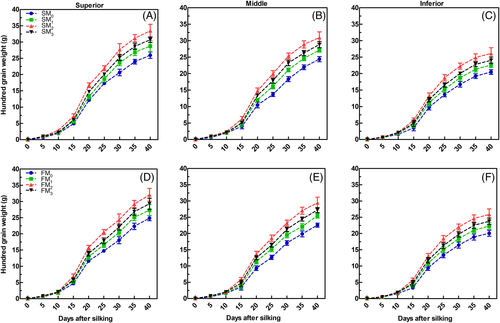
3.2 Endogenous hormone levels during grain filling
3.2.1 IAA and Z+ZR contents
In the seed filling process, the plant hormone IAA plays a crucial role and the application of exogenous melatonin transiently improved the content of IAA at the initial grain filling stage and reached the highest level 15 days after silking. The results showed that the treatment of melatonin as seed soaking SM2 significantly improved the content of IAA compared with foliar treatment FM2. The IAA content significantly increased at the early seed filling stage and reduced progressively with the improvement of seed filling at maturity (Figure 4). In the early filling period, the IAA content was greater in superior and middle seeds while lower in the inferior seeds. At the grain filling stage, the melatonin treatment slowly increases and then declines the IAA content. Upon SM2 and FM2 treatments, the IAA content reached its maximum value at 15 DAS in superior and middle seeds, whereas at 20 days in lower seeds. In the seed soaking methods, the IAA content was substantially higher in superior and middle seeds compared to the foliar application of melatonin.
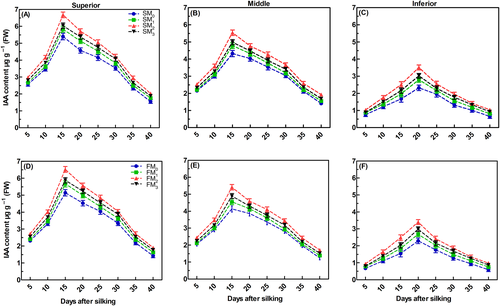
The Z+ZR is a plant hormone that plays a crucial role in the seed filling process. The content of Z+ZR improved drastically at the initial stage of seed filling and then declined progressively at the maturity stage. The Z+ZR contents in superior and middle seeds reached the maximum value at 20 DAS, while it was reached at 15 DAS in inferior seeds and then gradually declined with the progress of seed maturity (Figure 5). The content of Z+ZR positively correlated with the maximum seed filling rates, maximum seed weight, and mean seed filling rates. In superior seed, the value of Z+ZR was substantially higher than in middle seed and lower than in inferior seeds. Melatonin application enhanced the Z+ZR content significantly more in seed soaking as compared to foliar application. During the grain filling process, the Z+ZR contents increased and then declined gradually with the progress of seed maturity. Amomg the various melatonin treatments, SM2 and FM2 resulted in the highest Z+ZR contents as compared to control.
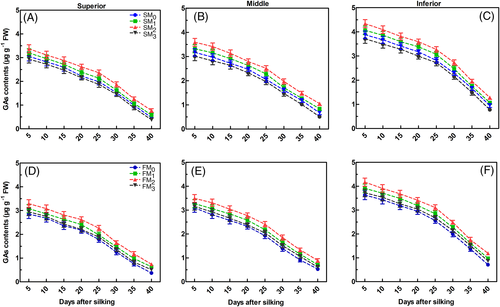
3.2.2 ABA and GA content
Our results showed that the ABA content in maize seeds increased rapidly at the early filling stage and then slowly decreased as the seeds mature. Melatonin application significantly inhibited the of ABA contents during the seed filling period, but a highest content of ABA was observed in seed soaking treatment compared with the foliar treatment. Figure 6 showed that the ABA content at the early stage of seed filling was higher in superior and middle seeds than in inferior seeds. In the later seed filling stage, the inferior seeds had an increased ABA content compared with the early stage, while ABA content decreased in superior and middle seeds. The ABA content was maximum at 20 DAS in superior and middle seeds and at 25 DAS in inferior seeds. The ABA content was higher in superior seeds, followed by the middle and inferior seeds. Melatonin applications increased the catabolism of ABA and have no substantial effect on ABA contents in the superior, middle, and inferior seed. The results of our study suggested that increasing the melatonin application reduced the ABA contents.
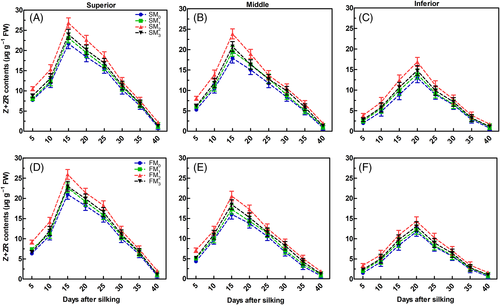
The application of melatonin to corn seeds significantly upregulated the GA biosynthesis. The results showed that GA content in the superior, middle, and inferior seeds decreased gradually in the course of the seed filling process (Figure 7). The inferior seeds have a substantially higher GA content than the superior and middle seeds. The increase in GA content was significantly higher when the seeds were soaked with melatonin compared to the foliar application of melatonin. The results showed that the SM2 and FM2 treatments are better compared with the other melatonin concentrations. The GA contents were highest at 5 DAS, while lower at 40 DAS in all treatments. During the seed filling process, the GA contents decreased gradually.
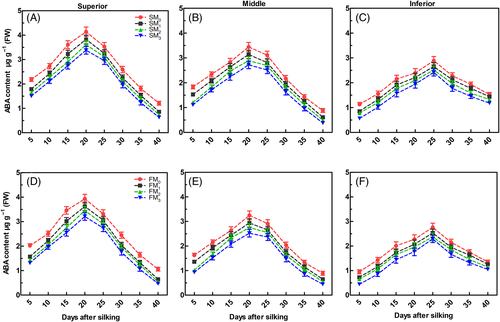
3.3 Total dry matter accumulation per plant
The total dry matter per plant (above-ground part) varied considerably between seed soaking and foliar application of melatonin with different concentrations. Our results showed a steady development of the dry matter per plant from seedling to maturity stage (Figure 8). The melatonin seed soaking method (SM2) increased more the dry matter accumulation per plant compared with the foliar application treatment FM2. At every stage of growth, the dry matter per plant improved by increasing the concentration of melatonin to a certain amount in both foliar application and seed soaking system. Among all the treatments, SM2 and FM2 showed the best results. The mean results during both years showed that the dry matter per plant increased at SM1, SM2, and SM3 treatments by 10.43, 32.68, and 22.02%, while it increased by 8.96, 31.55, and 21.18% upon FM1, FM2, and FM3 treatments compared with control.
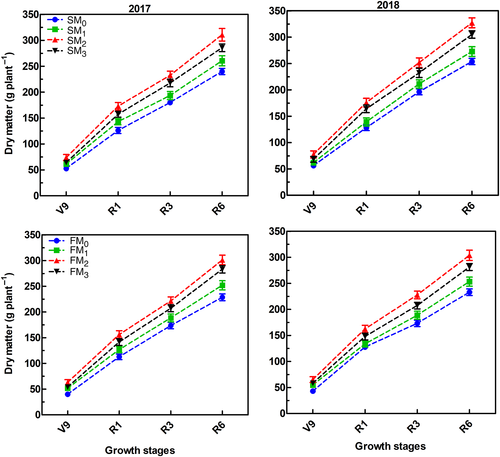
3.4 Ear characteristics and grain yield
The application of melatonin significantly increased maize yield and ear characteristics during 2017 and 2018. Table 2 showed that melatonin treatment as seed soaking SM2 improved more the length of the ear (cm), row per ear, ear diameter (mm), grain per row, and grain yield (kg per m2) compared with foliar application treatment FM2. The 2017 and 2018 results revealed that treatment with SM2 improved ear length 21.10 and 12.45%, ear diameter by 10.93 and 9.72%, row per ear by 16.75 and 13.66%, grain per row by 29.3 and 28.30%, and grain yield by 45.3 and 46.0%, while FM2 treatment increased ear length by 15.67 and 18.42%, ear diameter by 10.91 and 12.52%, row per ear by 9.73 and 10.51%, grain per row by 25.54 and 26.00%, and grain yield by 34.8 and 37.8% compared with the control. Overall, our results showed that melatonin application as a seed soaking treatment SM2 was better compared to the foliar application treatment FM2.
| Year | Treatments | Ear length (cm) | Ear diameter (mm) | Rows ear−1 | Grains row−1 | Grains yield (kg m−2) |
|---|---|---|---|---|---|---|
| 2017 | SM0 | 15.3c | 42.8d | 13.5c | 28.9c | 0.81d |
| SM1 | 16.4bc | 44.2c | 14.4b | 31.4b | 0.97c | |
| SM2 | 18.5a | 47.4a | 15.8a | 37.4a | 1.17a | |
| SM3 | 17.2b | 46.2b | 15.0b | 33.1b | 1.08b | |
| FM0 | 15.2c | 41.8c | 13.7c | 28.9c | 0.81d | |
| FM1 | 16.2b | 42.6c | 14.3b | 30.9bc | 0.88c | |
| FM2 | 17.5a | 46.3a | 15.0a | 36.3a | 1.09a | |
| FM3 | 16.9a | 44.4b | 14.9ab | 33.1b | 0.98b | |
| 2018 | SM0 | 15.7c | 42.8c | 13.8b | 29.8d | 0.83c |
| SM1 | 16.2bc | 44.0b | 14.4b | 31.8c | 1.01b | |
| SM2 | 17.7a | 46.9a | 15.7a | 38.2a | 1.21a | |
| SM3 | 17.2ab | 45.7ab | 15.7a | 34.4c | 1.15a | |
| FM0 | 14.8b | 41.4d | 13.6c | 29.8c | 0.83c | |
| FM1 | 15.1b | 43.4c | 14.3b | 31.2bc | 0.98b | |
| FM2 | 17.6a | 46.5a | 15.1a | 37.5a | 1.14a | |
| FM3 | 17.1a | 44.2b | 14.5ab | 33.1b | 1.09a |
- Note: 0 (SM0), 25 (SM1), 50 (SM2), and 75 (SM3) μM L−1 melatonin as a seed soaking while 0 (FM0), 25 (FM1), 50 (FM2), and 75 (FM3) μM L−1 melatonin as a foliar application at ninth leaf stage during maize growth season 2017 and 2018. Values are given as means ± sd and different small letters within a column indicate significant differences across all treatments at P ≤ 0.05 (lsd test).
3.5 Correlation between hormones content and characteristics of seed filling
The correlation analysis coefficient shown in Figure 9 showed that the endogenous IAA, Z+ZR, and GA contents were significantly correlated with the maximum seed weight, mean, and maximum seed filling rate in upper (superior), lower (inferior), and middle seeds. However, ABA content was negatively correlated with the maximum seed weight, mean seed rate, and maximum seed filling rate in upper (superior), middle seeds, while the mean and maximum seed filling rate in lower (inferior) seeds were positively correlated.
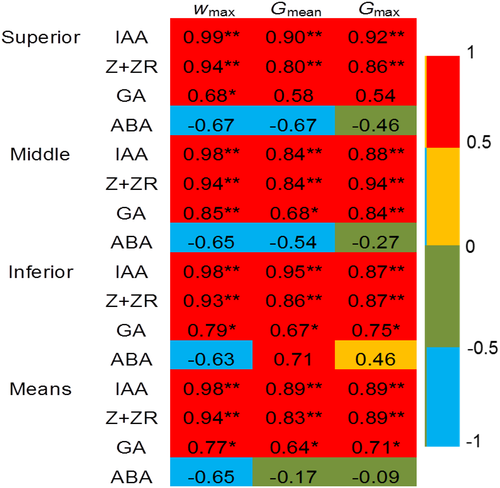
4 DISCUSSION
4.1 Melatonin effects on grain filling characteristics of maize
Farmers are facing water deficits due to global climate changes (Shao et al., 2008). The crop productivity and dry land farming system in the semiarid regions of northwestern China is highly dependent on natural precipitation and the scarcity of water is a significant limiting factor for the crop yield (Ren et al., 2008). Crop production is reported to be reduced due to this water deficit and unpredictable precipitation in the semiarid regions of China (Tang et al., 2011). The use of plant growth regulators increases crop productivity in semiarid areas (Ahmad et al., 2020; Kamran et al., 2018). Grain filling is a critical time for the formation of crop yields, and the improvement in grain filling may lead to increased crop production (Liu, Han, et al., 2015). The process of grain filling is regulated by plant endogenous hormone contents; however, the use of exogenous PGRs also plays a crucial role in grain filling (Lv, Han, et al., 2017; Qin et al., 2013). A previous study indicated that exogenous application of PGRs melatonin under stress conditions is critical for plant growth and development (Fleta-Soriano et al., 2017). In the current research, melatonin treatment as a foliar spray and seed soaking resulted in increased maize production in semiarid areas. The use of melatonin as seed soaking substantially improved maize production and yield components compared with foliar treatment. The results showed that maize treated with melatonin (SM2 and FM2) had higher ear characteristics and yield. Melatonin application significantly increased the filling rate of seeds by controlling the endogenous hormone content and increased grain yield in semiarid areas. Higher content of indole 3-acetic acid and Z+ZR significantly improved dry matter accumulation in seeds and increased grain yield. Previous study indicated that PGRs increase the seed filling rate and grain yields significantly under water deficit conditions (Liu et al., 2016). Melatonin is a plant growth regulator that increased the seed weight and yield in soybean (Posmyk et al., 2008).
4.2 Grain hormonal variable responses to different application methods of melatonin
Seed filling determines the weight of seeds, which represents a significant agronomic trait for the production of maize (Liu et al., 2016). Zhang et al. (2010) reported that maize seeds were classified into three classes: superior, middle, and inferior seeds according to the degree of seed filling rate. Previous studies indicated that the maize yield potential could be divided into the following yield components: ear length and diameter, number of grains per ear, number rows per ear, and grain weight (Liu et al., 2004). In this study, the exogenous application of melatonin significantly increased the seed filling rate in the superior, middle, and inferior seeds. Melatonin treatments as seed soaking tremendously increased the rate of seed filling compared to foliar application. The SM2 and FM2 melatonin treatments increased the seed filling levels compared to the control. Previous studies suggested that, during the seed filling stage, the levels of CK and IAA remain nearly the same (Zhang et al., 2009). They are closely linked to seed development and are generally found in maize seed endosperms, which are essential for cell division (Yang et al., 2002; Zhang et al., 2009). Several studies have shown that cytokinin is indispensable for cell division at the early stage of seed filling in barley, maize, wheat, and rice (Morris et al., 1993; Saha et al., 2011; Yang et al., 2000). Our results showed that the IAA and Z+ZR content in the early seed filling stage increased significantly and reached a maximum at 15 DAS in superior and middle seeds, and at 20 DAS in inferior seeds before gradually declining thereafter with the progress of maturity. In superior seeds, the IAA and Z+ZR were substantially higher followed by middle seed and lower seeds. The application of melatonin, either SM2 or FM2, greatly increased the contents of IAA and Z+ZR compared with control and other treatments. Our findings conclude that the content of IAA and Z+ZR is necessary for seed production and plays an important role in the progression of maize seed filling. IAA and Z+ZR contents could normalize the maize seed filling rate in the early silking stage and are generally found in the grain of maize endosperm as they are essential for cell division (Jia et al., 2018). The higher IAA content in a seed could increase cytokinin content in seeds (Singh & Gerung, 1982). The results endorse that IAA and cytokinin may regulate maize grain filling in the early silking stage, most likely via the manipulation of endosperm cell division, thereby enhancing the seed filling rate. The correlation analysis showed that the content of IAA and Z+ZR correlates significantly and positively with the maximum seed weight, mean seed filing rate, and maximum seed filling rate. The content of Z+ZR and IAA is vital for the regulation of the filling rate of maize grains. It also suggested that IAA and Z+ZR are effective plant hormones for filling wheat and maize seeds (Liu, Fang, et al., 2015; Liu, Han, et al., 2015). Previous research suggested that IAA and cytokinin play a critical role in regulating the grain filling time (Guowei et al., 2007).
4.3 Hormonal response in seed filling process and maize production
In addition, the ABA content also played a vital role in seed filling process. Previous work indicates that the ABA content was associated with the seed filling rate (Yang et al., 2010). The correlation analysis of our findings presented that the content of ABA in inferior seeds was positively correlated with the mean and the maximum seed filling rate, whereas that was negatively correlated in superior and middle seeds. At the early stage of seed filling in the superior and middle seeds, the ABA content was higher as compared to the inferior seeds. In seed filling, the ABA content increased significantly from 5 DAS to 20 DAS in the superior and middle seeds and 25 DAS in the inferior seeds and then decreased gradually to 40 DAS. Our results followed a similar trend as described by Yang et al. (2006), who reported that in the later seed filling stage, ABA content increased in inferior seeds and decreased in middle and superior seeds. Generally, melatonin induces the catabolism of ABA, upregulate the GA biosynthesis, and other important hormones for seed germination (Hai-Jun et al., 2015). The plant hormone GA is also regulating the process of seed filling and grain development. Previous studies reported that peas and rice panicles had the highest GA content before anthesis. Our results showed that GA content was significantly lowest in the superior seeds and highest in the bottom seeds followed by middle seeds (Kurogochi et al., 1979; Suzuki et al., 1981). Our findings are consistent with previous studies where higher GA levels were reported in the inferior seed followed by middle seed but lower in the superior maize seeds (Liu, Han, et al., 2015). Our findings also showed that the melatonin seed soaking treatment SM2 resulted in a higher amount of GA than the foliar application treatment FM2. The findings showed that hormonal regulation regulates the cycle of seed filling in corn, rather than individual hormone content.
Melatonin plays important and diverse functions in plants, including delaying leaf senescence and improvement of plant productivity (Wang et al., 2016). Our results indicated that the dry matter per plant was steadily improved from seedling to the physiological maturity stage. The seed soaking process increased the dry matter per plant more than the foliar melatonin application. Previous reports have shown that exogenous applications of melatonin and other plant hormones accelerate cell division and extension and improve biomass accumulation in plants (Ramón et al., 2012; Zeng et al., 2018). Hernández-Ruiz et al. (2004) conveyed that melatonin was used effectively to manage plant growth and production under water scarcity conditions. Our results indicated that melatonin application increased maize yields and yields components significantly in semiarid regions. Previous work also showed the use of melatonin as a PGRs to improve winter wheat yields (Fan et al., 2018; Ye et al., 2016).
The correlation analysis showed that Z+ZR and IAA contents were significantly correlated with the maximum seed weight of GA, mean, and maximum filling rate of seed. Whereas the ABA content was positively correlated with the mean and maximum filling rate of seeds in inferior seeds, it was negatively correlated with the maximum seed weight, mean and maximum filling rate in higher seed and middle seed. Previous work indicates that cytokinin can control the cell division of endosperm in the production of rice grain and Auxin also stimulate cell division (Davies, 1987; Guowei et al., 2007). Our findings showed that IAA and Z+ZR improved the filling of maize grains in the early filling time, further manipulated the endosperm cell division, and thereby enhanced the sink strength. These results suggested that exogenous melatonin treatment as a seed soaking and foliar applications are valuable for higher yield in the semiarid region. Our findings showed that melatonin application as seed soaking at 50 μM and a foliar application at 50 μM on the ninth stage of the leaf increased the total dry matter and seed filling rate by improving the hormonal changes in the seeds, which affected the characteristics of ear and increased the yield of maize under the semiarid region.
5 CONCLUSIONS
The exogenous application of PGRs, including melatonin, is one of most potential approaches for enhancing maize productivity in the semiarid water deficit regions. Our results indicated that melatonin treatments significantly enhanced the dry matter accumulation per plant, seed filling rate, ear characteristics, and final yield of maize crop. Endogenous hormone contents were significantly improved by the melatonin seed soaking treatment in superior, middle, and inferior seeds compared with the foliar application of melatonin treatment. The application of melatonin improved the contents of IAA, Z+ZR, and GA that were significantly correlated with the maximum seed weight, mean seed filling rate, and mean seed filling rate in superior, middle, and inferior seed compared to the control. Our results revealed that the exogenous application of melatonin SM2 and FM2 treatments significantly raised the seed filling rate as well as improved hormonal changes in maize and grain yield. To conclude, melatonin at a rate of 50 μM as a seed soaking and foliar application in the ninth stage of the leaf improves the production and yield of maize components in semiarid regions.
ACKNOWLEDGMENT
Funding for this study was provided from “High Technology Research and Development Program of China” (863 Program, No. 2013AA102902).
AUTHOR CONTRIBUTIONS
Conceptualization: Shakeel Ahmad and Qingfang Han. Methodology: Shakeel Ahmad, Muhammad Kamran, and Irshad Ahmad. Formal analysis: Shakeel Ahmad, and Xiangping Meng. Investigation: Shakeel Ahmad, Muhammad Kamran, Irshad Ahmad, Anas Iqbal, Wennan Su., Xiaorong Wu, and Guoyun Wang. Resources: Parvaiz Ahmad and Qingfang Han. Data curation: Shakeel Ahmad and Muhammad Kamran. Writing-original draft preparation: Shakeel Ahmad and Xunbo Zhou. Writing—review and editing: Parvaiz Ahmad, Muhammad Kamran, Irshad Ahmad, and Tehseen Javed. Supervision: Qingfang Han. All authors have read and agreed to the published version of the manuscript.
Open Research
DATA AVAILABILITY STATEMENT
The data that support the finding of this study are available from the corresponding author upon reasonable request.



